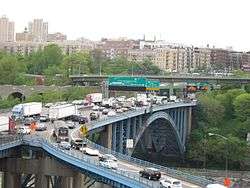Alexander Hamilton Bridge
| Alexander Hamilton Bridge | |
|---|---|
|
From the south, showing truck traffic | |
| Coordinates | 40°50′44″N 73°55′43″W / 40.8456°N 73.9287°WCoordinates: 40°50′44″N 73°55′43″W / 40.8456°N 73.9287°W |
| Carries |
8 lanes of |
| Crosses | Harlem River |
| Locale | Manhattan and the Bronx, in New York City |
| Maintained by | NYSDOT |
| Characteristics | |
| Design | Arch bridge |
| Total length | 2,375 feet (724 m) |
| Width | [1] |
| Longest span | 555 feet (169 m) |
| Clearance below | 103 feet (31 m) |
| History | |
| Opened | January 15, 1963 |
| Statistics | |
| Daily traffic | 185,309 (2012)[2] |
| Toll | none |
 Alexander Hamilton Bridge Location in New York City | |
The Alexander Hamilton Bridge carries eight lanes of traffic over the Harlem River in New York City between the boroughs of Manhattan and the Bronx, connecting the Trans-Manhattan Expressway in the Washington Heights section of Manhattan and the Cross-Bronx Expressway, as part of Interstate 95. The bridge opened to traffic on January 15, 1963, the same day that the Cross-Bronx Expressway was completed. For 2011, the New York City Department of Transportation, which operates and maintains the bridge, reported an average daily traffic volume in both directions of 182,174; having reached a peak ADT of 192,848 in 1990.[3]
The total length of bridge, including approaches, is 2,375 feet (724 m). The parallel main spans of the steel arch bridge stretch 555 feet (169 m) long over the Harlem River and provide 103 feet (31 m) of vertical clearance at the center and 366 feet (112 m) of horizontal clearance.
History
After completion of the George Washington Bridge in 1931, traffic off that bridge into the Bronx would travel over the Washington Bridge, which crosses the Harlem River just north of the present Alexander Hamilton Bridge. The Alexander Hamilton Bridge was planned in the mid-1950s to connect Robert Moses' proposed Trans-Manhattan and Cross-Bronx Expressways and to accommodate the additional traffic resulting from the addition of the six-lane lower level to the George Washington Bridge. With the Interstate designation, 90% of the $21 million in construction costs were covered by the federal government. The bridge design included a set of spiraling ramps (colloquially known as "The Corkscrew") to connect to and from the Major Deegan Expressway (completed in 1964) and a viaduct ramp connecting to the Harlem River Drive, both of which are over 100 feet (30 m) below the level of the Bridge, and access to Amsterdam Avenue.
The bridge recently underwent a full renovation which began in 2009 and continued through 2013. The construction estimate was $400 million. As of July 15, 2012, one of the eastbound lanes of the bridge had been closed to accommodate construction vehicles.[4] While the traffic jams created from the construction had not been as bad as local officials had anticipated, inbound delays at the Hudson River crossings increased after the project began.[5] The renovation of the bridge was the premise of The Weather Channel show Iron Men.
See also
-
 Bridges portal
Bridges portal -
 New York portal
New York portal -
 New York City portal
New York City portal - List of bridges documented by the Historic American Engineering Record in New York
References
- ↑ "2011 New York City Bridge Traffic Volumes" (PDF). New York City Department of Transportation. October 2013. Retrieved 2013-02-28.
- ↑ "2012 New York City Bridge Traffic Volumes" (PDF). Retrieved 2014-09-23.
- ↑ "2011 New York City Bridge Traffic Volumes" (PDF). New York City Department of Transportation. March 2010. p. 74. Archived (PDF) from the original on 28 May 2010. Retrieved 2013-02-28.
- ↑ Schweber, Nate (15 July 2012). "Bracing for Big Traffic Jam That Didn't Come on Day 1". The New York Times. Retrieved 1 August 2012.
- ↑ Wander, Erik. "GWB Traffic Getting Worse, Analysis Shows". Patch Media. Retrieved 1 August 2012.
External links
| Wikimedia Commons has media related to Alexander Hamilton Bridge. |
- New York State Department of Transportation - Alexander Hamilton Bridge Project
- NYC Roads: Alexander Hamilton Bridge
- Historic American Engineering Record (HAER) No. NY-302, "Alexander Hamilton Bridge, Spanning Harlem River between Bronx & Manhattan, Bronx, Bronx County, NY", 1 photo, 1 photo caption page
- Alexander Hamilton Bridge at Structurae
- Bridge and Tunnel Club pictures of the Alexander Hamilton Bridge
- Nautical Chart #12342 NOAA.
